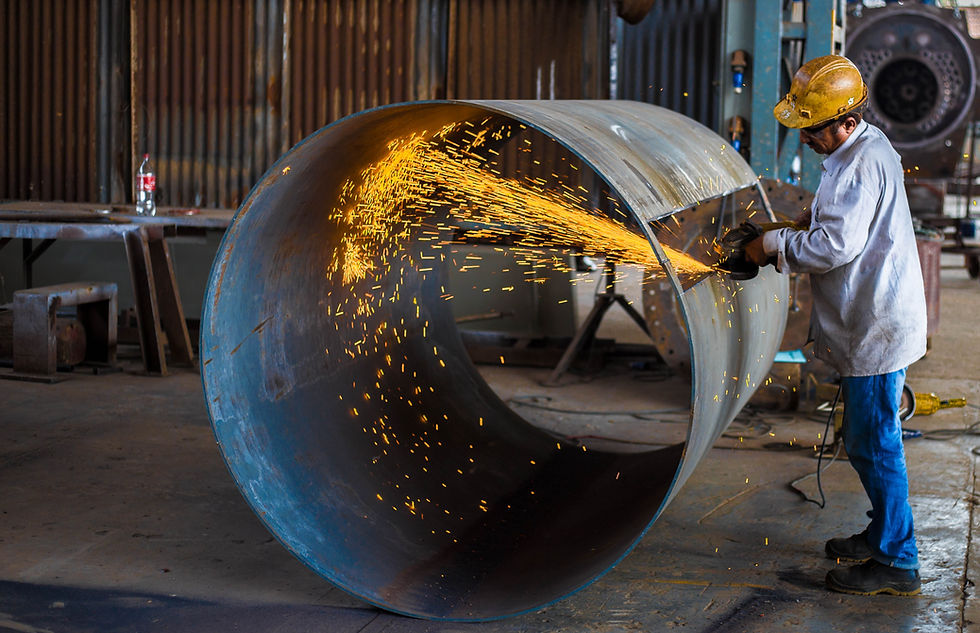Why should we examine metal?
- Kathryn
- Apr 28, 2021
- 4 min read
Updated: Apr 3
There are many ways to test and examine sample metal, and they require detailed recording of all the data collected to compare and analyse.

Accurate record-keeping is imperative, as this is evidence that technicians, metallurgists and engineers need to evaluate failure, how metals react with each other, and their strengths and weaknesses and to ensure quality standards are maintained in manufacturing engineering.
The data collated from examining the structure of metals can provide useful information and often, this is a quality control procedure where scientists will examine the grains in the metal using a range of optical microscopes.
Producers of raw material or finished metal products must pass the compliance standards. Ensuring there are no defects and the material is of high quality could enable the manufacturer to avoid major liabilities; reducing failure to satisfy the end consumer.
The metals and their alloys reflect casting or deformation process projects, like rolling or forging which then undergo heat treatment, fabrication and welding, which are often linked to mechanical, chemical and metallurgical tests in a wide range of ferrous and non-ferrous materials, used in the Industrial sectors ie Manufacturing Engineering that requires Metallurgy processes.
Investigating and examining metal is not only used in failure analysis, but process designers will also study the structure of metals to acquire confidence that the material meets the industrial requirements. This helps manufacturing engineering designers to choose the correct metal or alloy with the right properties for specific products.
The engineering designers will need to know the metals' range of mechanical and metallurgical properties. It is important to select the right material when designing vehicles, household goods and to use materials that are "fit for purpose".
The process for this provides assurance and confidence in the product, and this is commonly known as "Metallography".
Metallography links your existing metallurgical knowledge and application, but practical skills can only be learnt by using "hands-on" methods. One can gain knowledge from reading books, but there is no substitute for having actual "hands-on" experience of examining metals and acquiring analytical skills of different metals.
Microscopic Examinations
Microstructure means the structure that requires high magnification to be visible.
To understand how metals perform in certain situations, you would look at, for example:
Grain size, location of the test - longitudinal or transverse in terms of working or casting direction.
Malleability or ductile - Are the grains deformed? What is their shape? Other effects like dislocation or planes?
Ductility - do the grains and the matrix classification suggest this could be the case?
Brittleness - are the grains and matrix classification likely to produce this property?
Failure - is it a production problem or a service?
Examining the metal's properties under a microscope by polishing or etching the surface will show data about the size, shape of the grains, and the processing it has undertaken. It will also detail the metal's structure.

Before examining your metal under Macro or Micro conditions using a range of microscopes, you have to prepare it by visually considering the diagrams and photographs to determine the following:
Record-keeping
Hardness testing at the surface
Your sample will need to be mounted on a hot or cold mounting press for protection
Supporting information on the method of manufacture and process route, along with the specification and standards
Cutting - keeping records and samples
Grinding and polishing - keeping cool and observing each operation
Examination of the sample unetched
Examination of the sample etching
Hardness macro and micro sections
Metallographic Etching
This process reveals the microstructural details, which may not be evident when the sample is polished, but etching removes some non-metallic inclusions and provides grains and their matrix.
It will reveal the properties of the metal, grain shape and size, and other aspects, such as mechanical deformation and thermal treatments.
There are 3 main etching processes used in metallography:
Chemical
Electrolytic
Thermal
Chemical Etching
This involves immersing or swabbing the surface of your sample in an etchant. The etchant will corrode the microstructural features.
Electrolytic Etching
This process is similar to electropolishing, except electrolytic etching uses lower voltages.
Thermal Etching
This process involves oxidising your sample in a furnace. Using heat will induce oxidation of the surface at different rates, which are explored at a later stage.
Failure Analysis
To achieve accurate and dependable results, it is essential to have an experienced technician or metallurgist who can comprehend and interpret the expected components or detect any deficiencies. By employing the mentioned techniques, the metallographer can assess metal failures by contrasting the faulty part with a sound one or by adhering to industry standard specifications.
Training
If you're keen on expanding your knowledge, our website provides a variety of learning opportunities for you to explore. All our online courses are conducted in real time, allowing you to engage with the instructor. The lectures and workshops that take place in the UK offer practical learning experiences.
Don't forget to subscribe to our upcoming workshops/events/newsletter so you don't miss our updates.









Comments